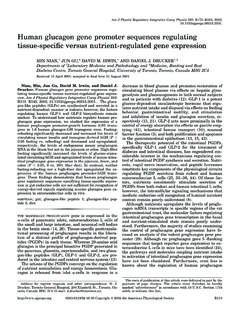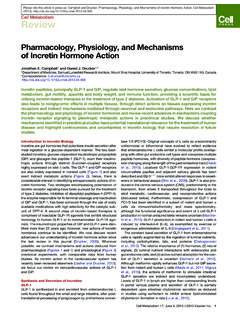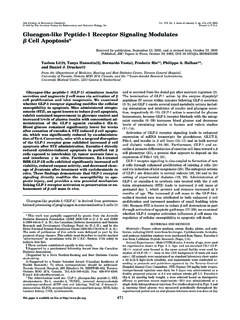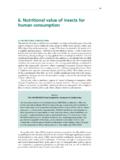Transcription of Structure-Function of the Glucagon Receptor Family …
1 Receptors and Channels, 8:179 188, 2002. Copyright c 2002 Taylor & Francis 1060-6823/02 $ + .00. DOI: Structure-Function of the Glucagon Receptor Family of G Protein Coupled Receptors: The Glucagon , GIP, GLP-1, and GLP-2 Receptors P. L. Brubaker Departments of Physiology and Medicine, University of Toronto, Toronto, Ontario, Canada D. J. Drucker Department of Medicine, Banting and Best Diabetes Centre, Toronto General Hospital, Toronto, Ontario, Canada convertases results in the liberation of Glucagon in the pancreatic The Glucagon -like peptides include Glucagon , GLP-1, and A cell, and GLP-1 and GLP-2 in the intestinal L cell and brain GLP-2, and exert diverse actions on nutrient intake, gastrointesti- (Mojsov et al. 1986; Orskov et al. 1987). As discussed below, nal motility, islet hormone secretion, cell proliferation and apopto- all three proglucagon-derived peptides (PGDPs) play impor- sis, nutrient absorption, and nutrient assimilation. GIP, a related member of the Glucagon peptide superfamily, also regulates nutri- tant roles in the physiologic regulation of nutrient homeosta- ent disposal via stimulation of insulin secretion.
2 The actions of these sis, through effects on energy intake and satiety, nutrient fluxes peptides are mediated by distinct members of the Glucagon recep- through and across the gastrointestinal tract, and energy as- tor superfamily of G protein coupled receptors. These receptors similation. Several of these biological activities are shared by exhibit unique patterns of tissue-specific expression, exhibit consid- a fourth Glucagon -related peptide hormone, glucose-dependent erable amino acid sequence identity, and share similar structural and functional properties with respect to ligand binding and sig- insulinotropic peptide (GIP) (Table 1). The diverse biological nal transduction. This article provides an overview of the biology activities of these Glucagon -related peptides are exerted through of these receptors with an emphasis on understanding the unique highly specific G protein coupled receptors (GPCR), members actions of Glucagon -related peptides through studies of the biology of the Glucagon Receptor superfamily.
3 For the purposes of this of their cognate receptors. article, the biological activities and mechanisms of action of each of these peptides will be discussed individually. Keywords Diabetes, GIP, GLP-1, GLP-2, Glucagon , Glucose, Intestine, Regulatory Peptides Biological Actions of the Glucagon -Related Peptides Glucagon GENERAL INTRODUCTION Glucagon is a 29 amino acid peptide hormone liberated from The gastroenteropancreatic-brain axis expresses a diverse islet A cells in the endocrine pancreas. The principal actions number of peptide hormones, including several that are struc- of Glucagon involve regulation of metabolic pathways involved turally related to the pancreatic hormone, Glucagon (Table 1). in glucose homeostasis. Glucagon secretion from the A cell is Within the mammalian Glucagon superfamily of peptides, coupled to the ambient levels of circulating glucose, with hypo- Glucagon and the Glucagon -like peptides, GLP-1 and GLP-2, glycemia and hyperglycemia leading to stimulation and inhibi- are all encoded by a single proglucagon gene (Bell et al.)
4 1983; tion of Glucagon release, respectively (Unger 1985). Glucagon Irwin 2001; White and Saunders 1986). Tissue-specific action in the liver impinges on numerous enzymes important posttranslational processing of proglucagon by prohormone for control of gluconeogenesis, glycogenolysis, and fatty acid metabolism, leading to restoration of circulating glucose con- centrations in the setting of energy depletion. The actions of Address correspondence to Daniel J. Drucker, , Banting and Glucagon on hepatic glucose production are exerted at multiple Best Diabetes Centre, Toronto General Hospital, 200 Elizabeth Street, levels, including regulation of gene transcription and modula- Toronto, Ontario, M5G 2C4 Canada. E-mail: tion of enzyme activity (Pilkis and Granner 1992). Defective 179. 180 P. L. BRUBAKER AND D. J. DRUCKER. TABLE 1. The amino acid sequences of human Glucagon , GLP-1, GLP-2, and GIP. Glucagon HSQGTFTSDYSKYLDSRRAQDFVQWLMNT. GLP-1 HAEGTFTSDVSSYLEGQAAKEFIAWLVKGRG.
5 GLP-2 HADGSFSDEMNTILDNLAARDFINWLIQTKITD. GIP YAEGTFISDYSIAMDKIRQQDFVNWLLAQ. Glucagon secretion contributes to the development of hypo- mia did not produce significant changes in palmitate flux in nor- glycemia in insulin-treated patients with diabetes (Gerich 1988; mal or diabetic human subjects (Jensen et al. 1991). Similarly, Taborsky, Jr. et al. 1998). subcutaneous infusion of Glucagon into the gastrocnemius mus- Glucagon receptors are widely expressed in multiple tissues cle or abdominal tissue had no effects on lipolysis rates or blood including the liver, brain, pancreas, heart, kidney, and smooth flow in normal human subjects (Bertin et al. 2001; Gravholt muscle cell in the gastrointestinal tract and peripheral vascula- et al. 2001). Glucagon modulates electrical activity in gastroin- ture. In the heart, Glucagon stimulates inotropic and chronotropic testinal smooth muscle (Patel et al. 1979; Taylor et al. 1975), activity (Parmley et al. 1968), leading to the selective use of leading to its clinical use as spasmolytic agent for modulation Glucagon in medical emergencies characterized by refractory of motility during endoscopic and radiologic examination of the bradycardia due to beta blocker toxicity or cardiogenic shock gastrointestinal tract.
6 (White 1999). Supraphysiological levels of Glucagon also exert vasodilator effects by reducing vascular resistance in specific vascular beds (Farah 1983). Glucagon -Like Peptide-1 and Glucose-Dependent Glucagon infusion activates nephrogenic adenylyl cyclase Insulinotropic Peptide (leading to increased urinary cAMP excretion), increases the The incretin concept was first developed in 1930 to describe glomerular filtration rate, and regulates ion transport and elec- the observation that administration of glucose by the oral route trolyte excretion in the kidney (Ahloulay et al. 1992; Broadus was associated with a greater increment in insulin secretion than et al. 1970; Schwartz Sorensen et al. 1993). Although hypo- was a euglycemic load given intravenously (Elrick et al. 1964;. glycemia is associated with increased hepatic and renal glu- LaBarre and Still 1930). This concept was further refined by both cose production, a role for Glucagon in the regulation of renal Unger (Unger and Eisentraut 1969) and Creutzfeldt (Creutzfeldt gluconeogenesis is unclear (Cersosimo et al.))
7 1999; Stumvoll 1979) to define an incretin as a gut hormone released in response et al. 1997, 1998). Whether Glucagon actions on the kidney to nutrient ingestion that stimulates glucose-dependent insulin are essential for regulation of renal physiology remains to be secretion. The first incretin to be identified was the duodenal determined. hormone, GIP. Although initially reported to possess gastric in- Within the brain, PGDPs, including Glucagon , are synthe- hibitory actions (Brown 1982; Brown and Dryburgh 1971), GIP. sized principally in the brainstem and, to a lesser extent, in was subsequently discovered to be a potent stimulator of insulin the hypothalamus (Drucker and Asa 1988); however, Glucagon - secretion (Dupre et al. 1973). Subsequent studies using GIP re- immunoreactive nerve fibers are widely distributed through the ceptor antagonists have clearly established that GIP fulfills all mammalian central nervous system (Dorn et al. 1983). Glucagon of the requirements for an incretin (Baggio et al.
8 2000; Lewis administration elicits a broad spectrum of actions, including et al. 2000; Tseng, Kieffer et al. 1996). However, reports that stimulation of anterior pituitary hormone secretion (Spathis et al. immunoneutralization of GIP does not abolish the incretin effect 1974), hypothalamic somatostatin release (Shimatsu et al. 1983), of ingested nutrients (Ebert and Creutzfeldt 1982; Ebert et al. and ketone utilization (Kirsch and D'Alecy 1984). Intracere- 1983), led to an ongoing search for additional insulinotropic broventricular administration of Glucagon potently suppresses gut hormones. It was not until 1987 that the second major in- food intake in the rat (Inokuchi et al. 1984) and enhances sym- cretin was discovered to be another member of the Glucagon - pathetic nerve activity (Krzeski et al. 1989; Shimizu et al. 1993), Family of peptides, GLP-1 (Kreymann et al. 1987; Mojsov et al. whereas Glucagon suppresses the activity of hypothalamic 1987; Orskov and Nielsen 1988).
9 Numerous studies on the in- glucose-sensitive neurons but has no effect on cortical neurons sulinotropic actions of GIP and GLP-1 have now established in the rat (Inokuchi et al. 1986). that, together, these peptides constitute the majority of the in- Glucagon stimulates lipolysis in isolated adipocyte prepara- cretin effect following ingestion of a meal, and that the two hor- tions from young animals (Heckemeyer et al. 1983; Lefebvre and mones contribute equivalently to this effect (Kieffer and Habener Luyckx 1969); however, these actions are significantly attenu- 1999). The importance of GIP and GLP-1 in glucose homeosta- ated with aging or weight gain (Bertrand et al. 1980). The poten- sis is suggested by the strong degree of sequence conservation tial importance of Glucagon for stimulation of human adipocyte that exists for each of these hormones (Irwin 2001). Consistent lipolysis is less clear (Richter et al. 1989; Richter and Schwandt with this hypothesis, Receptor antagonist studies and the analysis 1985).
10 Glucagon withdrawal or physiological hyperglucagone- of mice with null mutations in the receptors for GIP (GIPR) or Structure-Function OF G PROTEIN COUPLED RECEPTORS 181. GLP-1 (GLP-1R) have demonstrated that loss of GIP or GLP- Tsai, Hill, Asa et al. 1997; Tsai, Hill, and Drucker 1997). The 1 action results in an impaired insulin response to oral glucose intestinotrophic effects of GLP-2 are mediated by stimulation (Miyawaki et al. 1999; Scrocchi et al. 1996). Whether these pep- of crypt cell proliferation and inhibition of apoptosis in both tides are the sole hormones mediating the incretin effect awaits the crypt and villus compartments of the small bowel (Drucker the development of mice with combined defects in both GIP et al. 1996; Tsai, Hill, Asa et al. 1997). GLP-2 administration and GLP-1 Receptor signaling. Finally, very recent studies have also results in inhibition of gastric emptying, reduced gastric indicated an exciting role for GLP-1 as a cell tropic factor.











